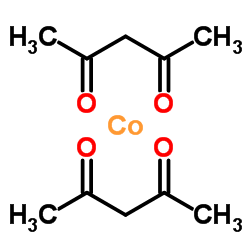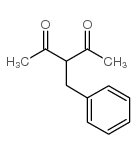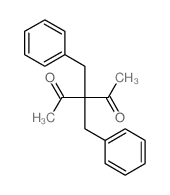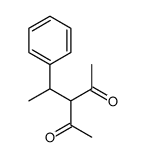14024-48-7
| 中文名 | 乙酰丙酮钴(II) |
|---|---|
| 英文名 | Cobalt(II) acetylacetonate |
| 中文别名 |
乙酰丙酮合钴
乙酰丙酮合钴(II) 双(2,4-戊二酮)钴(II) |
| 英文别名 |
Cobalt(II) Acetylacetonate
EINECS 244-527-6 Acetylacetone Cobalt(II) Salt 2,4-Pentanedione cobalt(II) derivative 2,4-Pentanedione cobalt(II) derivative (Bis(2,4-pentanedionato)cobalt 2,4-Pentanedione - cobalt (2:1) 2,4-Pentanedione, cobalt salt (2:1) Cobalt(II) 2,4-pentanedionate Bis(2,4-pentanedionato)cobalt(II) MFCD00000014 |
| 沸点 | 138.4ºC at 760mmHg |
|---|---|
| 熔点 | 165-170ºC |
| 分子式 | C10H16CoO4 |
| 分子量 | 259.165 |
| 闪点 | 43.1ºC |
| 精确质量 | 259.038055 |
| PSA | 68.28000 |
| LogP | 1.10900 |
| 外观性状 | 紫色固体 |
| 蒸汽压 | 0.174mmHg at 25°C |
| 储存条件 | 常温密闭避光,通风干燥 |
| 稳定性 | 常温常压下稳定 避免的物料:水分/潮湿 氧化物。具有腐蚀性。水合物为桃红色粉末。 |
| 水溶解性 | 5 g/L (20 ºC) |
| 计算化学 | 1、 氢键供体数量:0 2、 氢键受体数量:4 3、 可旋转化学键数量:4 4、 互变异构体数量:15 5、 拓扑分子极性表面积(TPSA):68.3 6、 重原子数量:15 7、 表面电荷:0 8、 复杂度:82.3 9、 同位素原子数量:0 10、 确定原子立构中心数量:0 11、 不确定原子立构中心数量:0 12、 确定化学键立构中心数量:0 13、 不确定化学键立构中心数量:0 14、 共价键单元数量:3 |
| 更多 | 1. 性状:白色单斜系晶体,通常以四聚体存在。 2. 密度(g/mL,25/4℃):1.43 3. 相对蒸汽密度(g/mL,空气=1):未确定 4. 熔点(ºC):241 5. 沸点(ºC,常压):未确定 6. 沸点(ºC,5.2kPa):未确定 7. 折射率:未确定 8. 闪点(ºC):未确定 9. 比旋光度(º):未确定 10. 自燃点或引燃温度(ºC):不适用的 11. 蒸气压(kPa,25ºC):未确定 12. 饱和蒸气压(kPa,60ºC):未确定 13. 燃烧热(KJ/mol):未确定 14. 临界温度(ºC):未确定 15. 临界压力(KPa):未确定 16. 油水(辛醇/水)分配系数的对数值:未确定 17. 爆炸上限(%,V/V):未确定 18. 爆炸下限(%,V/V):未确定 19. 溶解性:稍微可溶解的 |
|
SECTION 1: Identification of the substance/mixture and of the company/undertaking Product identifiers Product name: Cobalt(II) acetylacetonate REACH No.: A registration number is not available for this substance as the substance or its uses are exempted from registration, the annual tonnage does not require a registration or the registration is envisaged for a later registration deadline.
CAS-No.: 14024-48-7 Relevant identified uses of the substance or mixture and uses advised against Identified uses: Laboratory chemicals, Manufacture of substances SECTION 2: Hazards identification Classification of the substance or mixture Classification according to Regulation (EC) No 1272/2008 Acute toxicity, Oral (Category 4), H302 Acute toxicity, Inhalation (Category 4), H332 Acute toxicity, Dermal (Category 4), H312 Serious eye damage (Category 1), H318 Reproductive toxicity (Category 2), H361 For the full text of the H-Statements mentioned in this Section, see Section 16. Classification according to EU Directives 67/548/EEC or 1999/45/EC Xn HarmfulR20/21/22, R41 For the full text of the R-phrases mentioned in this Section, see Section 16. Label elements Labelling according Regulation (EC) No 1272/2008 Pictogram Signal wordDanger Hazard statement(s) H302 + H312 + H332Harmful if swallowed, in contact with skin or if inhaled H318Causes serious eye damage. H361Suspected of damaging fertility or the unborn child. Precautionary statement(s) P280Wear protective gloves/ eye protection/ face protection. P305 + P351 + P338IF IN EYES: Rinse cautiously with water for several minutes. Remove contact lenses, if present and easy to do. Continue rinsing. Supplemental Hazardnone Statements Other hazards - none SECTION 3: Composition/information on ingredients Substances Synonyms: Co(acac)2 Bis(2,4-pentanedionato)cobalt Cobaltous acetylacetonate 2,4-Pentanedione Formula: C10H14CoO4 Molecular Weight: 257,15 g/mol CAS-No.: 14024-48-7 EC-No.: 237-855-6 Hazardous ingredients according to Regulation (EC) No 1272/2008 ComponentClassificationConcentration Cobalt(II) acetylacetonate CAS-No.14024-48-7Acute Tox. 4; Eye Dam. 1;<= 100 % EC-No.237-855-6Repr. 2; H302 + H312 + H332, H318, H361 Hazardous ingredients according to Directive 1999/45/EC ComponentClassificationConcentration Cobalt(II) acetylacetonate CAS-No.14024-48-7Xn, R20/21/22 - R41<= 100 % EC-No.237-855-6 For the full text of the H-Statements and R-Phrases mentioned in this Section, see Section 16 SECTION 4: First aid measures Description of first aid measures General advice Consult a physician. Show this safety data sheet to the doctor in attendance. If inhaled If breathed in, move person into fresh air. If not breathing, give artificial respiration. Consult a physician. In case of skin contact Wash off with soap and plenty of water. Consult a physician. In case of eye contact Rinse thoroughly with plenty of water for at least 15 minutes and consult a physician. If swallowed Never give anything by mouth to an unconscious person. Rinse mouth with water. Consult a physician. Most important symptoms and effects, both acute and delayed The most important known symptoms and effects are described in the labelling (see section 2.2) and/or in section 11 Indication of any immediate medical attention and special treatment needed no data available SECTION 5: Firefighting measures Extinguishing media Suitable extinguishing media Use water spray, alcohol-resistant foam, dry chemical or carbon dioxide. Special hazards arising from the substance or mixture Carbon oxides, Cobalt/cobalt oxides Advice for firefighters Wear self contained breathing apparatus for fire fighting if necessary. Further information no data available SECTION 6: Accidental release measures Personal precautions, protective equipment and emergency procedures Use personal protective equipment. Avoid dust formation. Avoid breathing vapours, mist or gas. Ensure adequate ventilation. Evacuate personnel to safe areas. Avoid breathing dust. For personal protection see section 8. Environmental precautions Prevent further leakage or spillage if safe to do so. Do not let product enter drains. Methods and materials for containment and cleaning up Pick up and arrange disposal without creating dust. Sweep up and shovel. Keep in suitable, closed containers for disposal. Reference to other sections For disposal see section 13. SECTION 7: Handling and storage Precautions for safe handling Avoid contact with skin and eyes. Avoid formation of dust and aerosols. Provide appropriate exhaust ventilation at places where dust is formed. For precautions see section 2.2. Conditions for safe storage, including any incompatibilities Store in cool place. Keep container tightly closed in a dry and well-ventilated place. Moisture sensitive. Specific end use(s) Apart from the uses mentioned in section 1.2 no other specific uses are stipulated SECTION 8: Exposure controls/personal protection Control parameters Components with workplace control parameters Exposure controls Appropriate engineering controls Handle in accordance with good industrial hygiene and safety practice. Wash hands before breaks and at the end of workday. Personal protective equipment Eye/face protection Face shield and safety glasses Use equipment for eye protection tested and approved under appropriate government standards such as NIOSH (US) or EN 166(EU). Skin protection Handle with gloves. Gloves must be inspected prior to use. Use proper glove removal technique (without touching glove's outer surface) to avoid skin contact with this product. Dispose of contaminated gloves after use in accordance with applicable laws and good laboratory practices. Wash and dry hands. The selected protective gloves have to satisfy the specifications of EU Directive 89/686/EEC and the standard EN 374 derived from it. Full contact Material: Nitrile rubber Minimum layer thickness: 0,11 mm Break through time: 480 min Material tested:Dermatril® (KCL 740 / Z677272, Size M) Splash contact Material: Nitrile rubber Minimum layer thickness: 0,11 mm Break through time: 480 min Material tested:Dermatril® (KCL 740 / Z677272, Size M) data source: KCL GmbH, D-36124 Eichenzell, phone +49 (0)6659 87300, test method: EN374 If used in solution, or mixed with other substances, and under conditions which differ from EN 374, contact the supplier of the CE approved gloves. This recommendation is advisory only and must be evaluated by an industrial hygienist and safety officer familiar with the specific situation of anticipated use by our customers. It should not be construed as offering an approval for any specific use scenario. Body Protection Complete suit protecting against chemicals, The type of protective equipment must be selected according to the concentration and amount of the dangerous substance at the specific workplace. Respiratory protection Where risk assessment shows air-purifying respirators are appropriate use a full-face particle respirator type N100 (US) or type P3 (EN 143) respirator cartridges as a backup to engineering controls. If the respirator is the sole means of protection, use a full-face supplied air respirator. Use respirators and components tested and approved under appropriate government standards such as NIOSH (US) or CEN (EU). Control of environmental exposure Prevent further leakage or spillage if safe to do so. Do not let product enter drains. SECTION 9: Physical and chemical properties Information on basic physical and chemical properties a) AppearanceForm: powder Colour: violet b) Odourno data available c) Odour Thresholdno data available d) pHno data available e) Melting point/freezingMelting point/range: 165 - 170 °C - lit. point f) Initial boiling point and no data available boiling range g) Flash pointno data available h) Evapouration rateno data available i) Flammability (solid, gas) no data available j) Upper/lowerno data available flammability or explosive limits k) Vapour pressureno data available l) Vapour densityno data available m) Relative densityno data available n) Water solubilityno data available o) Partition coefficient: n- no data available octanol/water p) Auto-ignitionno data available temperature q) Decompositionno data available temperature r) Viscosityno data available s) Explosive propertiesno data available t) Oxidizing propertiesno data available Other safety information no data available SECTION 10: Stability and reactivity Reactivity no data available Chemical stability Stable under recommended storage conditions. Possibility of hazardous reactions no data available Conditions to avoid Avoid moisture. Incompatible materials Oxidizing agents Hazardous decomposition products Other decomposition products - no data available In the event of fire: see section 5 SECTION 11: Toxicological information Information on toxicological effects Acute toxicity no data available Inhalation: no data available Dermal: no data available Skin corrosion/irritation no data available Serious eye damage/eye irritation no data available Respiratory or skin sensitisation no data available Germ cell mutagenicity no data available Carcinogenicity IARC:2B - Group 2B: Possibly carcinogenic to humans (Cobalt(II) acetylacetonate) Reproductive toxicity no data available Suspected human reproductive toxicant Specific target organ toxicity - single exposure no data available Specific target organ toxicity - repeated exposure no data available Aspiration hazard no data available Additional Information RTECS: Not available May liberate 2,4-pentanedione upon decomposition. 2,4-Pentanedione has the following toxicological hazards: toxic, irritant, neurological hazard, teratogen, possible mutagen, target organ - thymus. In humans, 2,4-pentanedione is reported to cause contact dermatitis and contact urticaria., Depending on the intensity and duration of exposure, effects may vary from mild irritation to severe destruction of tissue. SECTION 12: Ecological information Toxicity no data available Persistence and degradability no data available Bioaccumulative potential no data available Mobility in soil no data available Results of PBT and vPvB assessment PBT/vPvB assessment not available as chemical safety assessment not required/not conducted Other adverse effects no data available SECTION 13: Disposal considerations Waste treatment methods Product Offer surplus and non-recyclable solutions to a licensed disposal company. Dissolve or mix the material with a combustible solvent and burn in a chemical incinerator equipped with an afterburner and scrubber. Contaminated packaging Dispose of as unused product. SECTION 14: Transport information UN number ADR/RID: -IMDG: -IATA: - UN proper shipping name ADR/RID: Not dangerous goods IMDG: Not dangerous goods IATA:Not dangerous goods Transport hazard class(es) ADR/RID: -IMDG: -IATA: - Packaging group ADR/RID: -IMDG: -IATA: - Environmental hazards ADR/RID: noIMDG Marine pollutant: noIATA: no Special precautions for user no data available SECTION 15 - REGULATORY INFORMATION N/A SECTION 16 - ADDITIONAL INFORMATION N/A |
|
毒理学数据: 1、急性毒性:大鼠口经LD50:670 mg/kg; 主要的刺激性影响: 在皮肤上面:刺激皮肤和粘膜;在眼睛上面:刺激的影响; 2、致敏作用:通过吸入可能造成敏化作用,通过皮肤接触可能造成敏化作用 生态学数据: 通常对水体是稍微有害的,不要将未稀释或大量产品接触地下水,水道或污水系统,未经政府许可勿将材料排入周围环境。
|
| 符号 |



GHS05, GHS07, GHS08 |
|---|---|
| 信号词 | Danger |
| 危害声明 | H302 + H312 + H332-H318-H361 |
| 警示性声明 | P280-P305 + P351 + P338 |
| 个人防护装备 | dust mask type N95 (US);Eyeshields;Gloves |
| 危害码 (欧洲) | Xn:Harmful; |
| 风险声明 (欧洲) | R22;R40;R42/43 |
| 安全声明 (欧洲) | S22-S24-S36/37-S45 |
| 危险品运输编码 | NONH for all modes of transport |
| WGK德国 | 3 |
| 海关编码 | 29420000 |
| 上游产品 0 | |
|---|---|
| 下游产品 6 | |
| 海关编码 | 2918300090 |
|---|---|
| 中文概述 | 2918300090 其他含醛基或酮基不含其他含氧基羧酸(包括酸酐、酰卤化物、过氧化物和过氧酸及该税号的衍生物). 增值税率:17.0% 退税率:9.0% 监管条件:无 最惠国关税:6.5% 普通关税:30.0% |
| 申报要素 | 品名, 成分含量, 用途 |
| Summary | 2918300090 other carboxylic acids with aldehyde or ketone function but without other oxygen function, their anhydrides, halides, peroxides, peroxyacids and their derivatives。Supervision conditions:None。VAT:17.0%。Tax rebate rate:9.0%。MFN tariff:6.5%。General tariff:30.0% |






![3-[(4-nitrophenyl)methyl]pentane-2,4-dione结构式](https://image.chemsrc.com/caspic/119/56699-21-9.png)

![[(2R,3R)-3-phenylbutan-2-yl]benzene结构式](https://image.chemsrc.com/caspic/493/1857-74-5.png)